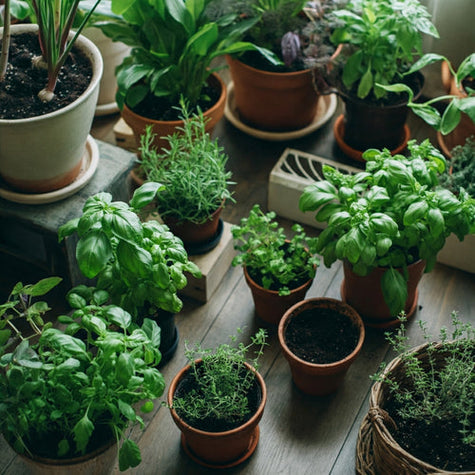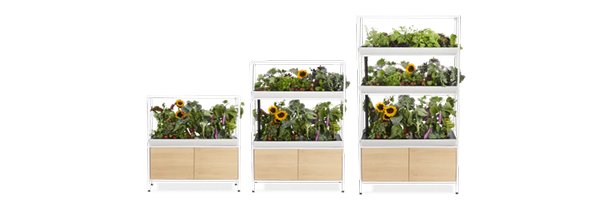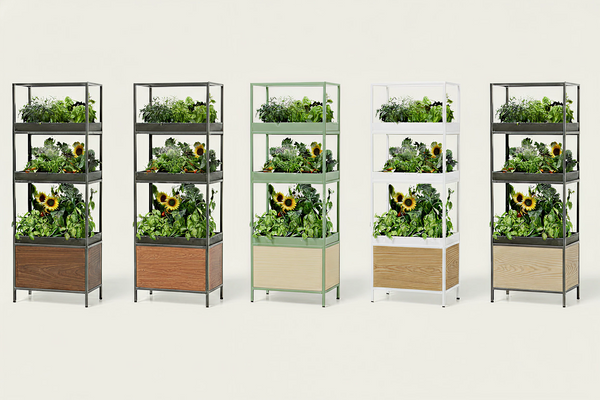Table of Contents
Discover the joy of indoor gardening and transform your home into a flourishing green oasis. Explore innovative techniques like vertical gardening and hydroponics to maximize space and yield while minimizing maintenance. Learn how to create a thriving indoor garden using compact containers, repurposed household items, and self-watering systems. Find out how to optimize light conditions, choose the right plants, and set up artificial lighting solutions for year-round growth. Embrace the satisfaction of harvesting fresh, homegrown produce regardless of space or season.
- Vertical gardening techniques maximize growing space in small areas
- Hydroponic systems provide precise nutrient delivery for optimal plant growth
- LED grow lights extend growing seasons and improve yields in low-light conditions
- Smart garden technology simplifies plant care through automated monitoring
- Indoor gardens produce fresh, pesticide-free vegetables faster than outdoor methods
Vertical Gardening Techniques
Living Walls and Green Facades
Transform your indoor space into a lush vertical oasis with living wall systems. These innovative structures integrate plants directly into wall surfaces, creating a stunning visual impact while maximizing growing area. The most effective systems combine four key elements:
- Waterproof backing to protect wall integrity
- Precision irrigation for optimal nutrient delivery
- Specialized growing media for vertical orientation
- Carefully selected plants suited for vertical conditions
Two main approaches define modern living wall design: modular panel systems and continuous felt systems. Modular systems use individual containers filled with growing media, supporting 15-20 plants per square meter. Felt-based systems create a continuous growing surface using layered synthetic fabrics, enabling denser plantings of 25-30 plants per square meter.
Growing Environment:
- Ambient temperature: 65-80°F (18-27°C)
- Humidity: 50-80%
- Irrigation: 2-3 times daily, adjusted seasonally
- Light: 12-14 hours daily (supplemented with LED grow lights if needed)
With proper care, living walls establish full coverage within 8-12 weeks, providing years of lush, vertical greenery. Monitor leaf color and soil moisture levels weekly to maintain optimal growing conditions and ensure your plants thrive[1].
Hanging Planters and Pocket Gardens
Maximize vertical growing space while adding visual interest with layered plant displays using hanging planters and pocket gardens. These versatile systems allow you to cultivate a variety of plants in even the smallest spaces.
For pocket gardens:
- Mount fabric organizers on walls to grow compact herbs and leafy greens
- Position to receive 4-6 hours of daily light
- Water 2-3 times weekly (fabric systems dry faster than traditional containers)
- Yield fresh harvests from 4-6 plants per pocket
Hanging planter tips:
- Choose lightweight containers with built-in drainage
- Secure mounting rated for 2-3 times the weight of saturated soil
- Group plants with similar water needs
- Monitor soil moisture daily in newly installed gardens until patterns emerge
Most hanging systems establish full growth coverage within 6-8 weeks when positioned in proper light conditions. Trailing plants like pothos thrive in these setups, with vines reaching 3-6 feet within one growing season.
Tiered Shelving Systems for PlantsMaximize vertical growing space while creating optimal light exposure for each plant level with tiered shelving systems. This approach allows you to cultivate a diverse range of plants in a compact footprint.
Key considerations:
- Build or select shelving units supporting 30-40 pounds per shelf
- Position shelves 12-16 inches apart vertically for proper growth and maintenance access
- Group plants with similar water and light requirements on the same tier
For areas with limited natural light, integrate LED grow lights under each shelf tier, extending growing hours to 12-14 daily for consistent plant development. Monitor moisture needs more frequently in tiered systems - upper shelves typically require 25% more frequent watering than lower levels due to increased air circulation and light exposure.
A standard 4-foot wide, 3-tier system accommodates 9-12 medium-sized plants while occupying only 6 square feet of floor space. This efficient use of vertical space allows you to create a thriving indoor garden even in compact living areas[2].
Compact Container Gardens
Windowsill Herb Gardens
Transform any sunny windowsill into a productive herb garden yielding fresh harvests year-round. With Rise Gardens' hydroponic systems, you can easily cultivate a variety of flavorful herbs right in your kitchen.
Optimal growing conditions:
- Light: 6-8 hours daily (south-facing windows ideal)
- Container depth: 4-6 inches with drainage holes
- Soil: Light potting mix amended with perlite for proper drainage
Group plants by water needs - drought-tolerant Mediterranean herbs like rosemary and sage together, moisture-loving basil and parsley in separate containers. Monitor soil moisture daily, watering when the top inch feels dry. Harvest stems regularly, cutting above leaf nodes to encourage bushier growth.
For low-light windows, supplement with LED grow lights providing 12-14 hours of light daily. Boost humidity by clustering containers and misting leaves weekly. A standard 3-foot windowsill accommodates 4-6 medium herb plants, yielding fresh harvests every 2-3 weeks with proper care[3].
Repurposed Household Items as Planters
Transform everyday household items into thriving plant habitats while reducing waste. This creative approach allows you to customize your indoor garden while giving new life to unused objects.
Planter ideas and growing tips:
- Glass jars and ceramic containers: Ideal for moisture-loving plants like pothos and ferns
- Drill 3-4 drainage holes in the bottom
- Add a 1-inch layer of pebbles before soil
- Tin cans: Perfect for herb gardens
- Punch drainage holes and paint exteriors with rust-resistant coating
- Supports upright growth of basil, oregano, and thyme
- 5-gallon plastic buckets: Productive vegetable containers
- Drill eight 1/4-inch drainage holes
- Fill with lightweight potting mix
- Old colanders: Ideal succulent planters with built-in drainage and airflow
Group containers by water needs - drought-tolerant plants in porous terra cotta, moisture-lovers in glazed ceramics. Monitor newly repurposed planters daily until watering patterns emerge, as different materials affect soil moisture retention. Most container plants establish full growth within 8-10 weeks when positioned in proper light conditions[4].
Self-Watering Container Systems
Maintain optimal soil moisture with self-watering containers that let plants draw water as needed. These innovative systems ensure consistent hydration, promoting healthier growth and reducing maintenance.
Basic DIY setup:
- Use a container with drainage holes
- Create wicks using cotton string
- Bury one end of each wick 2 inches into the soil
- Let the other end rest in a water reservoir below
For larger containers, create a dual-chamber system with a false bottom platform elevated 6-8 inches, allowing 4-6 quarts of water storage below. Cut drainage pipe into 6-inch sections to serve as wicking columns, covering 5-15% of the container's surface area.
Monitor reservoir levels through clear tubing or measurement sticks, topping up when levels drop below 25%. Plants establish fuller root systems within 4-6 weeks in self-watering containers compared to traditional pots, leading to 30-40% higher yields for vegetables like tomatoes and peppers[5].
Innovative Indoor Garden Structures
Indoor Greenhouse Setups
Create a controlled growing environment in any indoor space with a DIY greenhouse setup. This approach allows you to cultivate a wider variety of plants by maintaining optimal conditions year-round.
Key components:
- Glass-doored cabinets for creating microclimates
- Small humidifiers to maintain 65-80% humidity
- LED grow lights positioned 12-18 inches above plants (12-14 hours daily)
- Digital sensors for monitoring temperature and humidity
A standard glass cabinet accommodates 8-12 medium plants across 3-4 shelves while occupying just 4 square feet of floor space. Drill 1-inch ventilation holes near the top to prevent excess moisture buildup and open doors 1 hour daily for air circulation.
For seed starting, maintain soil temperatures between 70-75°F (21-24°C) using heat mats to achieve 90% germination rates within 5-7 days. Most indoor greenhouse setups establish thriving plant colonies within 4-6 weeks when environmental conditions are properly maintained.
Hydroponic Tower Gardens
Maximize growing space and efficiency with vertical hydroponic tower gardens. These innovative systems deliver precise nutrients through gravity-fed water systems, allowing you to grow more in less space.
System overview:
- Standard 5x5-foot area supports two towers housing 56 plants total
- Towers built using 5-inch vinyl fence posts with staggered growing ports
- 3-inch net pots in each port, supported by 45-degree PVC holders
- 45-gallon nutrient reservoir with scheduled pumping intervals
Maintenance tips:
- Monitor reservoir pH (5.5-6.5) and EC levels weekly
- Adjust nutrients based on crop needs
- Clean towers with diluted bleach solution between crop cycles
Most tower gardens establish full production within 4-6 weeks, yielding fresh harvests every 21-28 days when maintained at 65-75°F (18-24°C) with 12-14 hours of direct light[6].
Terrarium Designs for Small Spaces
Transform small spaces into thriving miniature ecosystems with carefully designed terrariums. These self-contained gardens create stunning visual displays while requiring minimal maintenance.
For closed terrariums:
- Layer materials: 1 inch drainage stones, landscape fabric, thin activated carbon layer, 2-3 inches sterile potting mix
- Select compact plants suited to high humidity (mosses, small ferns)
- Position in filtered light receiving 4-6 hours daily
- Monitor condensation patterns for proper moisture balance
For open designs:
- Group drought-tolerant succulents with similar water needs
- Use shallow containers with excellent drainage
- Create depth by varying plant heights
- Enhance displays with miniature landscape elements
A standard 12-inch terrarium houses 4-6 small plants while occupying minimal surface area. Most terrariums establish stable growing conditions within 4-6 weeks when positioned properly[7].
Maximizing Light in Small Indoor Gardens
Choosing Plants for Low-Light Conditions
Transform low-light areas into thriving gardens by selecting plants adapted to shade conditions. With the right choices, you can create lush, green spaces even in areas with limited natural light.
Top low-light plants:
- Peace lilies and snake plants: Thrive with 4-6 hours of indirect light daily
- ZZ plants: Flourish in darker corners receiving 2-4 hours of filtered light
- Pothos: Trail 3-6 feet in partial shade
- Dracaena varieties: Actively grow in low-light conditions, developing new leaves every 4-6 weeks
Growing tips:
- Group plants by light needs
- Monitor leaf color as growth indicators
- Water low-light plants 25-30% less frequently than sun-loving varieties
Most shade-tolerant plants establish full growth within 8-12 weeks when matched to available light levels[8].
Artificial Lighting Solutions
Transform indoor spaces into productive growing environments with LED grow lights that deliver precise light spectrums for each growth stage. These energy-efficient solutions allow you to cultivate a wide variety of plants regardless of natural light availability.
Lighting setup guide:
- Position full-spectrum LED fixtures 12-18 inches above plants
- Provide 12-14 hours of light daily for leafy greens and herbs
- Use fixtures that deliver 25-60 watts per square foot
- Add red spectrum light (630-660nm) for flowering plants during blooming phases
Choose between three main setup types:
- Overhead panels covering 4-5 square feet for multiple plants
- Adjustable gooseneck lights with 2-3 foot range for targeted growing
- Screw-in LED bulbs delivering 9-10 watts for single specimens
Most indoor plants establish healthy growth patterns within 2-3 weeks under proper LED lighting. Group plants with similar light needs together and use timers to maintain consistent photoperiods for maximum efficiency[9].
Reflective Surfaces to Enhance Natural Light
Maximize natural light in your indoor garden by strategically positioning reflective surfaces to redirect and amplify available sunlight. This technique can significantly increase light exposure for your plants without additional energy costs.
Reflective surface options:
- White painted walls: Reflect 85-90% of light while creating diffused illumination
- Reflective panels: Use white-painted boards or foylon (spun polyester with foil laminate)
- Specialized horticultural reflective films: Diffuse light evenly across plant canopies
Implementation tips:
- Install reflective panels on walls opposite windows to double light exposure
- Position plants near south-facing walls to benefit from both direct sun and reflected light
- For areas receiving 3-4 hours of direct light, add reflective mylar sheets to achieve 6-8 daily hours
- Avoid mirrors, which create intense hot spots
Monitor leaf response when adding reflectors - upward curling indicates too much intensity while stretching shows insufficient light. Most plants adapt to enhanced lighting within 2-3 weeks, developing compact growth and deeper foliage color[10].
Conclusion
With Rise Gardens' innovative hydroponic systems and these creative indoor gardening solutions, you can cultivate a thriving garden in any space, all year round. Our smart gardens combine cutting-edge technology with nature, allowing you to grow fresh, nutrient-rich produce with minimal effort. Experience the joy of harvesting pesticide-free vegetables right from your home, faster and more efficiently than traditional outdoor gardening methods.
Ready to start your indoor gardening journey? Visit Rise Gardens to explore our range of hydroponic systems and discover how easy it is to grow your own fresh, delicious produce at home.
- MDPI. (2019). Vertical Gardening Techniques for Small Spaces.
- Lettuce Grow Something. (n.d.). Elevate Your Home with an Indoor Vertical Herb Garden.
- Martha Stewart. (n.d.). Guide to Growing Kitchen Windowsill Herbs.
- Sustainability Tribe. (n.d.). Up-cycled Planters.
- Vertical Veg. (n.d.). How to Make a Genuinely Self-Watering Growing System.
- Oklahoma State University Extension. (n.d.). Building a Vertical Hydroponic Tower.
- Fanning Sparks. (n.d.). Miniature Garden in a Closed Terrarium DIY Tutorial.
- Lively Root. (n.d.). Low Light Plants Collection.
- The Spruce. (n.d.). Best Grow Lights.
- The Tye Dye Iguana. (n.d.). Use Reflective Surfaces to Maximize Plant Lighting.



